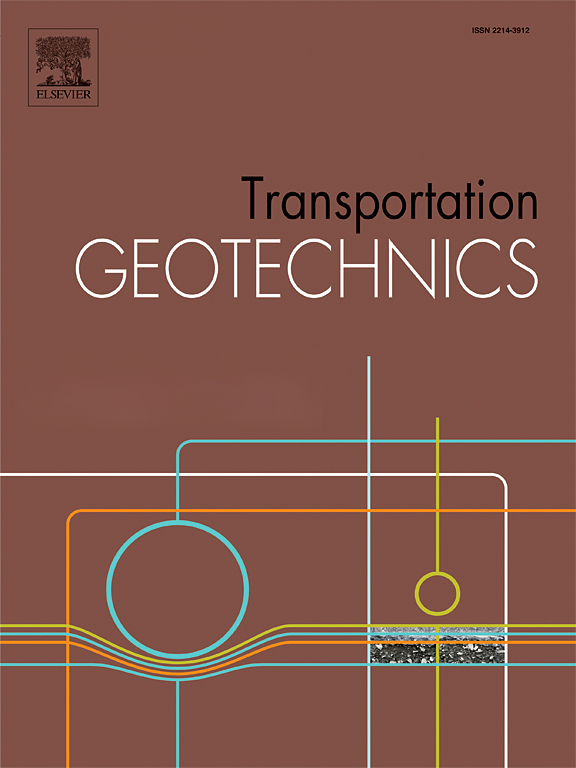Explainable machine learning-based prediction model for dynamic resilient modulus of subgrade soils
IF 4.9
2区 工程技术
Q1 ENGINEERING, CIVIL
引用次数: 0
Abstract
The dynamic resilient modulus (MR) of a subgrade soil is a fundamental parameter for evaluating the dynamic stability and service resilience of subgrade fillers and structures, as well as an instrumental input for calculating the mechanical response and fatigue life of a pavement structure. To accurately and reasonably characterise the MR of subgrade soils, machine learning (ML) models were established using the support vector machine, random forest, and extreme gradient boosting algorithms based on a large-scale dataset including 3533 records of MR tests conducted on subgrade soils. Meanwhile, the weighted plasticity index (WPI), initial moisture content (w), dry unit weight (γd), confining stress (σc), deviator stress (σd), and numbers of freeze–thaw cycles (NFT) were set as the input variables to predict the MR using ML models, which considered the effects of wheel loads, physical properties and climate fluctuation on the subgrade soils during the service period. Subsequently, the Shapley additive explanations method was developed to explain the prediction model for the MR of subgrade soils based on ML algorithms. The results quantitatively illustrated the explicit mapping relationship and internal influencing mechanism between the significant features of the influences and MR of subgrade soils, which was consistent with prior experimental and physical cognition. In summary, the study findings provide meaningful guidelines for the structural design and life evaluation of pavement subgrade engineering.
基于机器学习的路基土动态弹性模量可解释预测模型
路基土的动态弹性模量(MR)是评估路基填料和结构的动态稳定性和使用弹性的基本参数,也是计算路面结构的机械响应和疲劳寿命的工具输入。为了准确、合理地表征路基土的 MR,基于大规模数据集(包括 3533 条路基土 MR 测试记录),使用支持向量机、随机森林和极梯度提升算法建立了机器学习(ML)模型。同时,将加权塑性指数 (WPI)、初始含水量 (w)、干单位重量 (γd)、约束应力 (σc)、偏差应力 (σd)、冻融循环次数 (NFT) 设置为输入变量,使用 ML 模型预测 MR,其中考虑了使用期间轮载、物理特性和气候波动对路基土的影响。随后,开发了基于 ML 算法的 Shapley 加性解释方法来解释路基土的 MR 预测模型。结果定量说明了影响因素的显著特征与路基土的 MR 之间的明确映射关系和内在影响机理,这与之前的实验和物理认知是一致的。总之,研究结果为路面基层工程的结构设计和寿命评估提供了有意义的指导。
本文章由计算机程序翻译,如有差异,请以英文原文为准。
求助全文
约1分钟内获得全文
求助全文
来源期刊

Transportation Geotechnics
Social Sciences-Transportation
CiteScore
8.10
自引率
11.30%
发文量
194
审稿时长
51 days
期刊介绍:
Transportation Geotechnics is a journal dedicated to publishing high-quality, theoretical, and applied papers that cover all facets of geotechnics for transportation infrastructure such as roads, highways, railways, underground railways, airfields, and waterways. The journal places a special emphasis on case studies that present original work relevant to the sustainable construction of transportation infrastructure. The scope of topics it addresses includes the geotechnical properties of geomaterials for sustainable and rational design and construction, the behavior of compacted and stabilized geomaterials, the use of geosynthetics and reinforcement in constructed layers and interlayers, ground improvement and slope stability for transportation infrastructures, compaction technology and management, maintenance technology, the impact of climate, embankments for highways and high-speed trains, transition zones, dredging, underwater geotechnics for infrastructure purposes, and the modeling of multi-layered structures and supporting ground under dynamic and repeated loads.
 求助内容:
求助内容: 应助结果提醒方式:
应助结果提醒方式:


